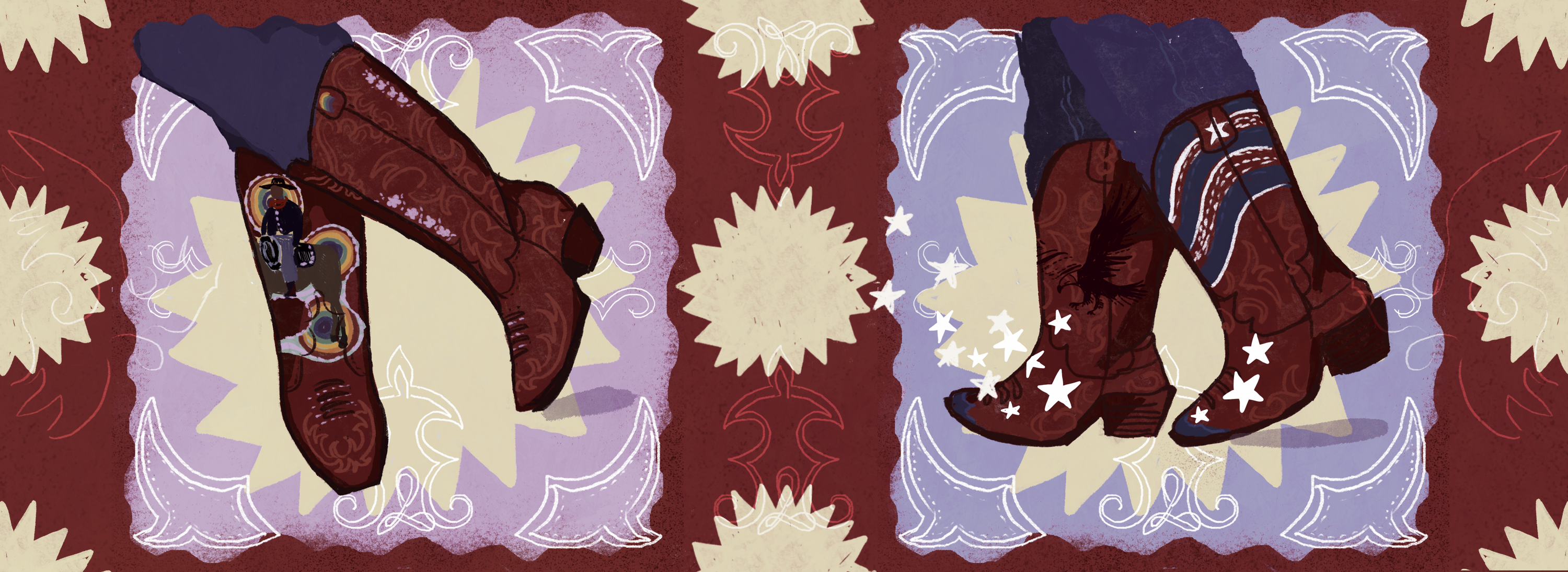reflections
Country is back — is conservatism next? by Ning Chang

An engaging feature on the connection of country music to conservatism in the U.S, this article by Ning Chang questions why the rise of country iconography in recent months means we may have to admit that, “we’re back to a conservative-coded social currency.” Waah.
It seems particularly apt to read this piece during Trump’s inauguration week – with country music stars Carrie Underwood and Billy Ray Cyrus singing at Trumpian events, both with major performance glitches. Could it be a sign?
masculinity threatened
American country music tends to trend towards being conservative-coded, due to its rural origins, and appeals to patriotism, faith and tradition. The symbolism around the genre is tied up with this too.
The image of the cowboy specifically – long-associated with country music – is one of the most enduring images of American western expansionism, rugged individualism and white masculinity. But like the notions of equality that the U.S was supposedly founded on, the conception of the cowboy as seen in Westerns and other popular culture, is a myth.
Centuries before the idea of the American cowboy existed, there were the Mexican vaqueros – largely Indigenous Mesoamerican men who wrangled cattle on horseback. They used different versions of what would become known as ‘lassos’, wore what would become ‘chaps,’ and even inspired rodeos. Only in the mid-1800s, when white Americans moved westward onto Mexican land, did those settlers pick up the mantle of ranches and herding cattle.
Other marginalised groups, rarely the go-to when thinking of wild west figures, also have a history within the cowboy space.
As Ning writes, “Even the “lone macho cowboy” was probably more Mexican, Black, Indigenous, and/or Brokeback Mountain than people would care to learn or admit.”
no country for old myths
Creating an idealised, white and self-reliant cowboy is part of a larger trend that the political right love: crafting stories and narratives which hark back to something simpler and less threatening. You don’t have to look far beyond a MAGA hat.
Yet in this election, at least they had a narrative. The Democrats could simply not put forward an attractive vision in a country clearly struggling. It was a depressing yet useful lesson in the ineffectiveness of centrists and liberals to invigorate the masses.
Country music has largely gone the same way as modern conservatism, especially after 9/11. The genre once upon a time was about working-class struggles, making references to working long hours for greedy bosses. But this has long been swapped for the jingoistic and reactionary themes of modern country music.
a glimmer of moonshine and hope
Having said that, Ning considers the current resurgence of the genre as a space which allows more adaptation and evolution, taking with it some of the original working-class and subversive elements and bringing it to a new audience. Maybe we’re not quite in the post-9/11 hysteria moment.
Conservatives may own the most powerful institutions of the land, but there is still scope for innovative culture to be crafted in spite of, or ideally in opposition to, nativist myths and glorified pasts.
As Ning articulates, “The fight over how we understand country in 2024 is nothing less than figuring out how we want to understand our context and ourselves. As politics influences culture, culture also influences politics. Revising our notion of country beyond nativism and conservatism in this moment of the genre’s cultural dominance could make space in American society for a way through this divisive moment.”
If we want to stop the conservative cultural takeover, let’s create leftist art which speaks to the material needs of people. Who knows class consciousness and the banjo?
~ Tommy
smirk of the week 😏

shado in focus
This week’s shado in focus listen is The Revolution is in 808 by Simmone Ahiaku, who spoke to Adèle Oliver, author of Deeping It: Colonialism, Culture & Criminalisation of UK Drill for this ep. It’s a perceptive and sharp take on a music genre which is increasingly demonised and criminalised.
“The true musicality of Drill, like many Black genres before it, is largely ignored,” says Ahiaku. “It does not get the credit it deserves for its storytelling, relatability and its stark portrayal of Black British and working-class life. In this way, drill acts as a periscope, showing us the inconspicuous ways people are surviving in this system.”
one thing to watch:
F.D Signifier – It’s Bigger Than Diddy
This is a great deep-dive by video essayist F.D Signifier into the culture of 1990s and 2000s American hip-hop, which enabled the rise and tolerance of P Diddy’s many crimes. It is a crucial analysis of why Diddy was not operating as a predator in a vacuum. Instead of treating him as an outlier, aberration or merely listing the accusations against him, F.D has gone to lengths to thoroughly research into the how and why Diddy operated from a position of power and impunity for so long.
The video is more like a documentary than a mini essay – it’s so long that I watched it in three sittings, but trust me it’s worth it! It includes many perceptive interviews and snippets of footage that will transport you to that era, and I left with a more rounded (and tragic) understanding of the whole situation.
Highly recommend!
…. Subscribe HERE for full free post.

